Table of Contents
- Introduction
- Editor’s Choice
- EHR Industry Overview
- Key EHR Industry Vendors Statistics
- EHR Industry Adoption Statistics
- Office-based Physicians with EMR/EHR Systems
- Capability of Physician EHR to Identify Patients for Care
- Impact of EHR on Patient Outcomes
- EHR Industry Statistics – By Region
- EHR Industry Benefits
- EHR Industry Challenges
- Regulations for EHR
Introduction
According to EHR Industry Statistics, Electronic Health Records are digital versions of patient paper charts. Revolutionizing healthcare by providing instant, secure access to comprehensive medical information.
They include details like medical history, diagnoses, medications, and test results, consolidating data from various sources into one accessible record.
EHRs enhance patient care by supporting better coordination among healthcare providers. Improving efficiency through reduced paperwork, and enabling patient engagement via access to their records.
Challenges include high implementation costs, interoperability issues between different systems, and concerns about data privacy.
Looking ahead, advancements aim to improve interoperability, enhance data analytics, and integrate with telemedicine for more efficient and personalized healthcare delivery.
Editor’s Choice
- The global Electronic Health Records (EHR) market revenue reached $27.1 billion in 2023.
- By 2033, the market is anticipated to reach $45.9 billion, with cloud-based solutions contributing $21.11 billion and on-premise solutions $24.79 billion. Reflecting a sustained and robust growth trajectory for both segments.
- The global Electronic Health Records (EHR) market is segmented by type into inpatient and outpatient EHR systems. In this market, inpatient EHR systems hold a dominant share, accounting for 55% of the market.
- As of the latest data, Epic Systems Corporation holds the largest market share among EHR vendors in the United States, commanding 28.21% of the market.
- The implementation of Electronic Health Records (EHR) has significantly improved various patient outcomes. Access to critical information has seen the most substantial enhancement. With an 80% improvement, facilitating timely and informed decision-making in patient care.
- As of 2019, the adoption of electronic medical records (EMR) among primary care physicians varied across selected countries, with New Zealand achieving full adoption at 100%.
- The implementation of Electronic Health Records (EHR) in India faces several significant challenges. Security and privacy concerns are paramount, affecting 28% of the implementation efforts, and are closely tied to the issue of lack of interoperability, which also impacts 28% of the initiatives.
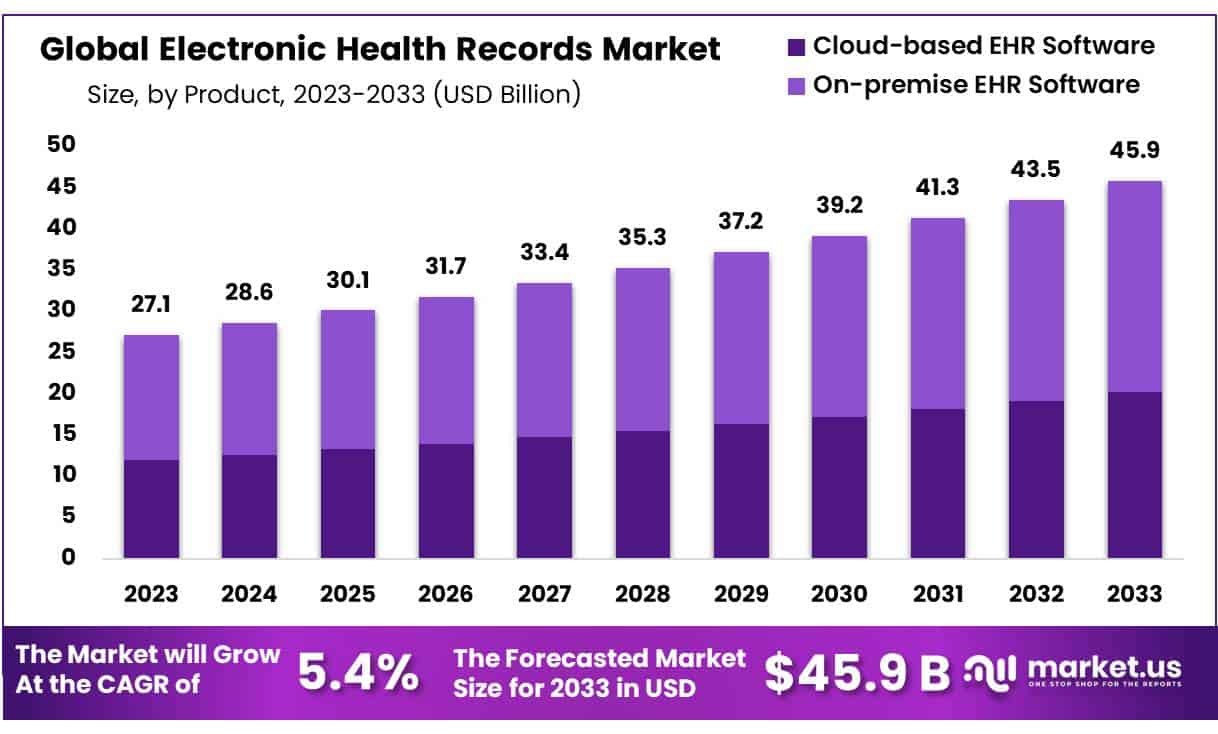
EHR Industry Overview
Global EHR Industry Size
- The global Electronic Health Records (EHR) market has demonstrated consistent growth at a CAGR of 5.4%, with revenues reaching $27.1 billion in 2023.
- By 2033, the market is anticipated to achieve a revenue of $45.9 billion. Underscoring the sustained expansion and growing adoption of electronic health records globally.
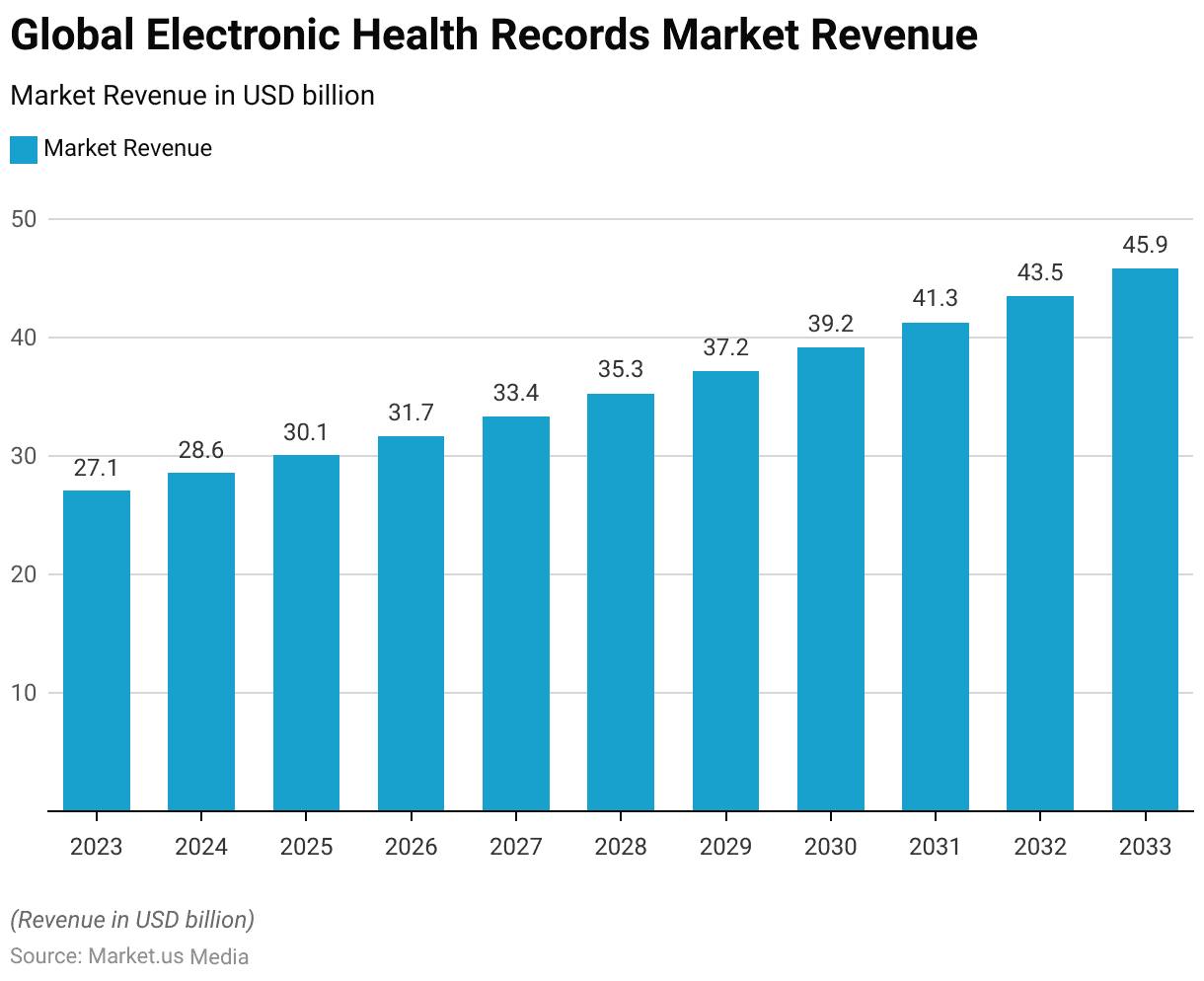
EHR Industry Size – By Product
- The global Electronic Health Records (EHR) market, segmented by product type, showcases significant growth in both cloud-based and on-premise EHR software revenues.
- In 2023, the total market revenue was $27.1 billion, with cloud-based EHR software contributing $12.47 billion and on-premise EHR software generating $14.63 billion.
- By 2033, the market is anticipated to reach $45.9 billion, with cloud-based solutions contributing $21.11 billion and on-premise solutions $24.79 billion. Reflecting a sustained and robust growth trajectory for both segments.
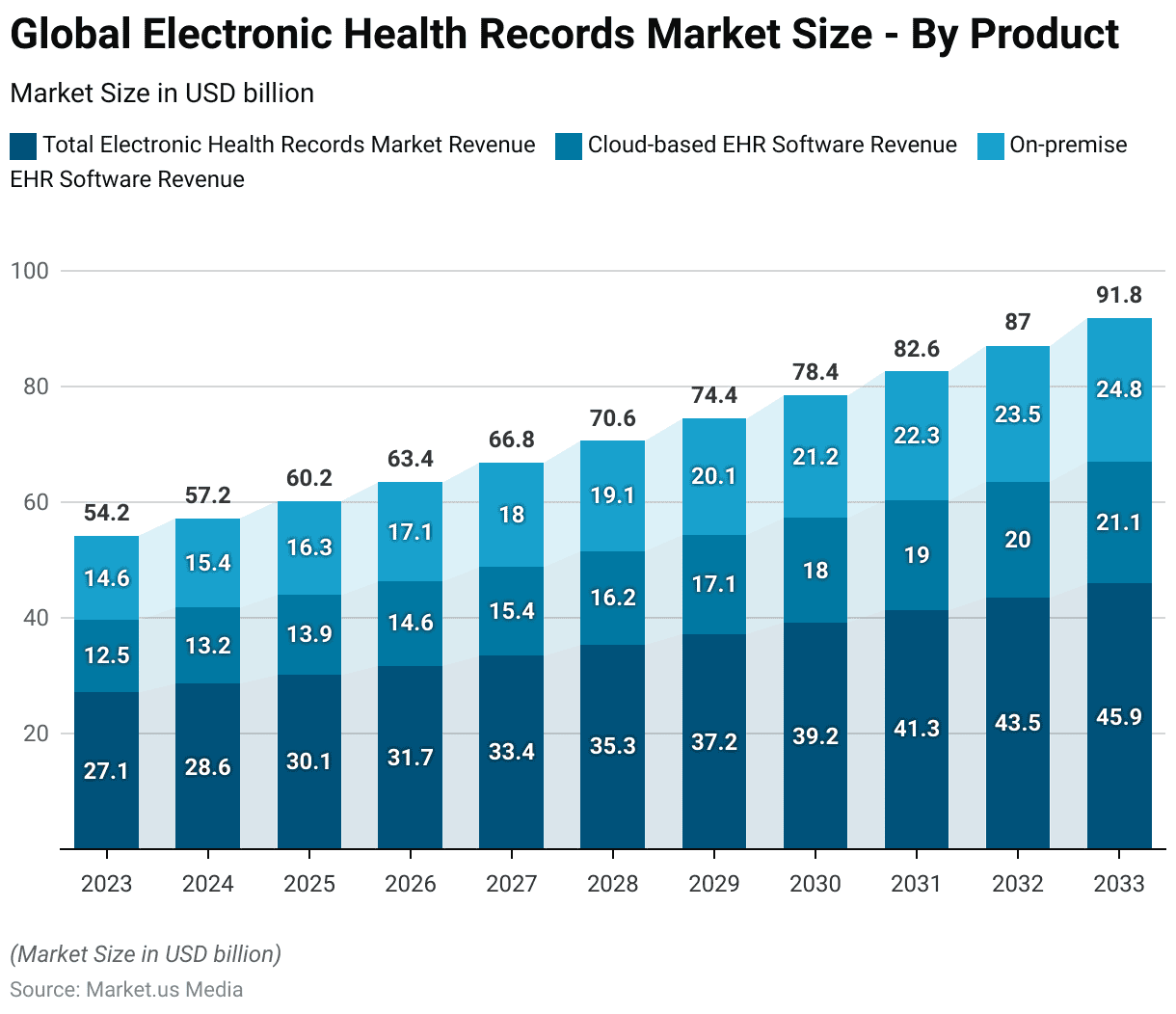
EHR Industry Share – By Type
- The global Electronic Health Records (EHR) market is segmented by type into inpatient and outpatient EHR systems.
- In this market, inpatient EHR systems hold a dominant share, accounting for 55% of the market.
- Outpatient EHR systems, on the other hand, comprise the remaining 45% of the market share.

Key EHR Industry Vendors Statistics
Top EHR Industry Vendors
- As of the latest data, Epic Systems Corporation holds the largest market share among EHR vendors in the United States, commanding 28.21% of the market.
- Allscripts follows with a 9.21% share, while eClinicalWorks, LLC accounts for 6.57%.
- Athenahealth and NextGen Healthcare have market shares of 6.03% and 5.37%, respectively.
- GE Healthcare holds 5.00% of the market, and Cerner Corporation has a 4.32% share.
- Greenway Health, LLC follows with 2.91%.
- Other vendors with smaller market shares include eMDs at 1.12%, Modernizing Medicine, Inc. at 1.09%, and MEDENT-Community Computer Service, Inc. and Integrated Practice Solutions, Inc. each with 1.03%.
- Practice Fusion has a market share of 0.89%, Mckesson holds 0.86%, and SRS-Health has the smallest share at 0.72%.
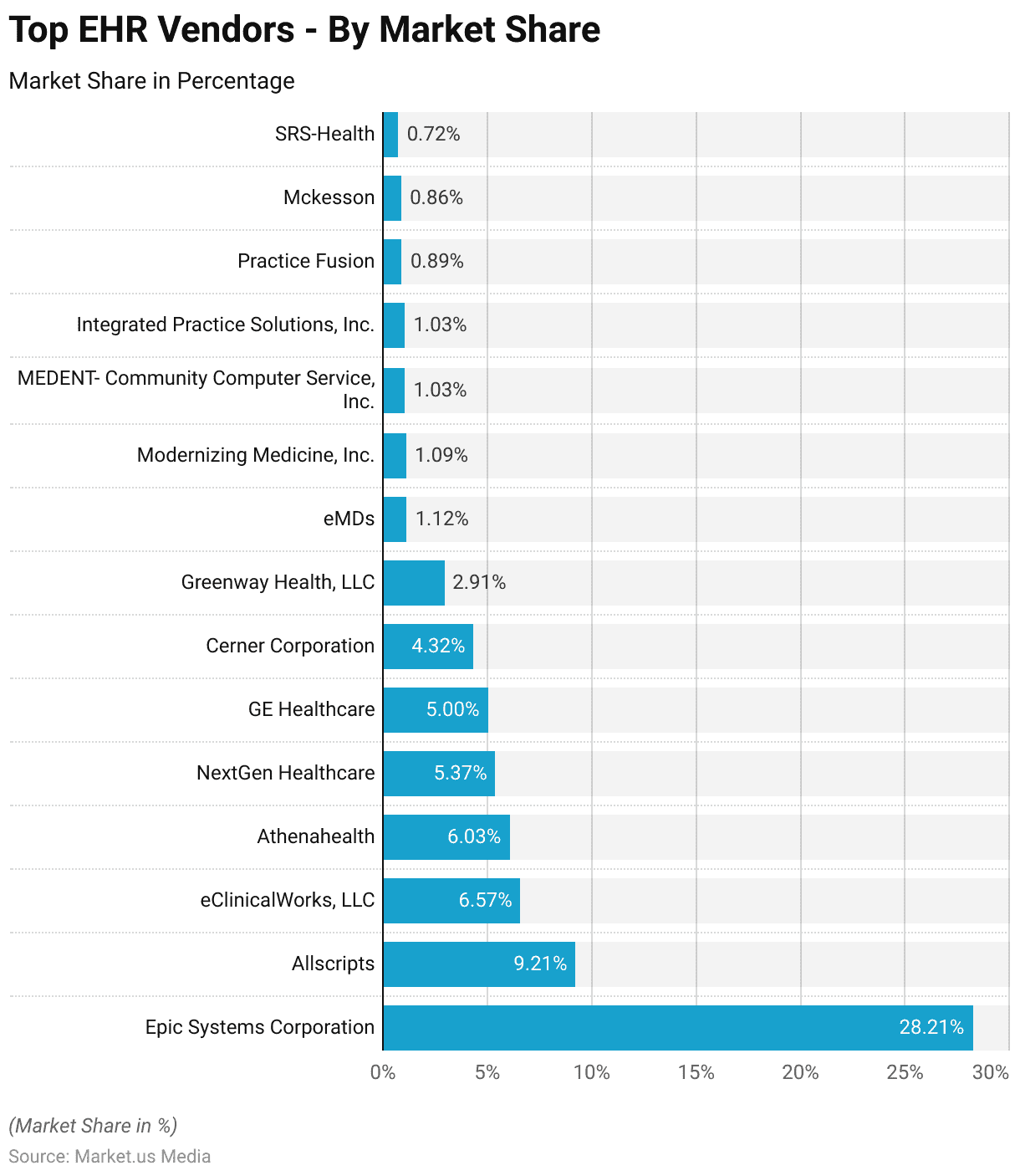
EHR Industry Adoption Statistics
Adoption of EHR Industry – By Hospital Service Type
- The adoption of Electronic Health Records (EHR) varies by hospital service type, demonstrating high levels of integration across different categories.
- General acute care hospitals exhibit a substantial adoption rate, with 96% utilizing any form of EHR, 94% implementing Certified EHR Technology (CEHRT), and 86% using the 2015 edition of CEHRT.
- Psychiatric hospitals have 84% adoption of any EHR, 75% CEHRT adoption, and 67% utilization of the 2015 CEHRT.
- Specialty hospitals report lower adoption rates, with 75% using any EHR, 40% implementing CEHRT, and 23% adopting the 2015 CEHRT.
- Rehabilitation hospitals have 81% using any EHR, 63% implementing CEHRT, and 40% utilizing the 2015 CEHRT.
- Children’s hospitals demonstrate high adoption, with 97% using any EHR, 90% implementing CEHRT, and 86% using the 2015 CEHRT.
- Acute long-term care hospitals report 92% using any EHR, 88% implementing CEHRT, and 79% utilizing the 2015 CEHRT.
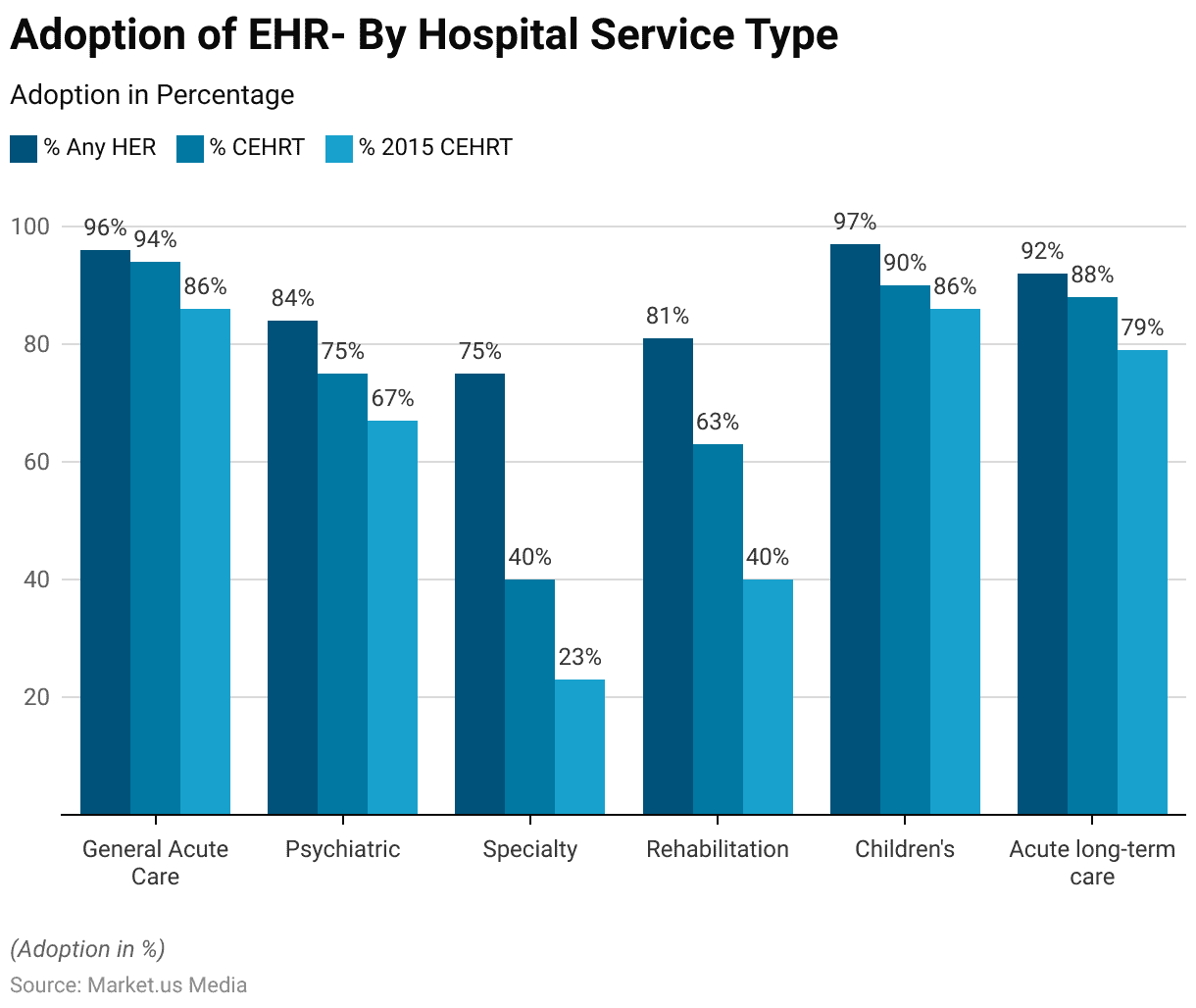
EHR Adoption by Primary Care Physicians – According to Country
- In 2019, the adoption of electronic medical records (EMRs) among primary care physician practices exhibited significant variation across different countries.
- The Netherlands and the United Kingdom led with a 99% adoption rate. Followed closely by Sweden at 98% and Australia at 97%.
- The United States also demonstrated a high adoption rate, with 91% of primary care practices reporting the use of EMRs, aligning with the comparable country average of 91%.
- France and Germany each reported an 88% adoption rate, while Canada showed a slightly lower rate at 86%.
- Switzerland lagged, with only 70% of primary care physician practices utilizing EMRs.
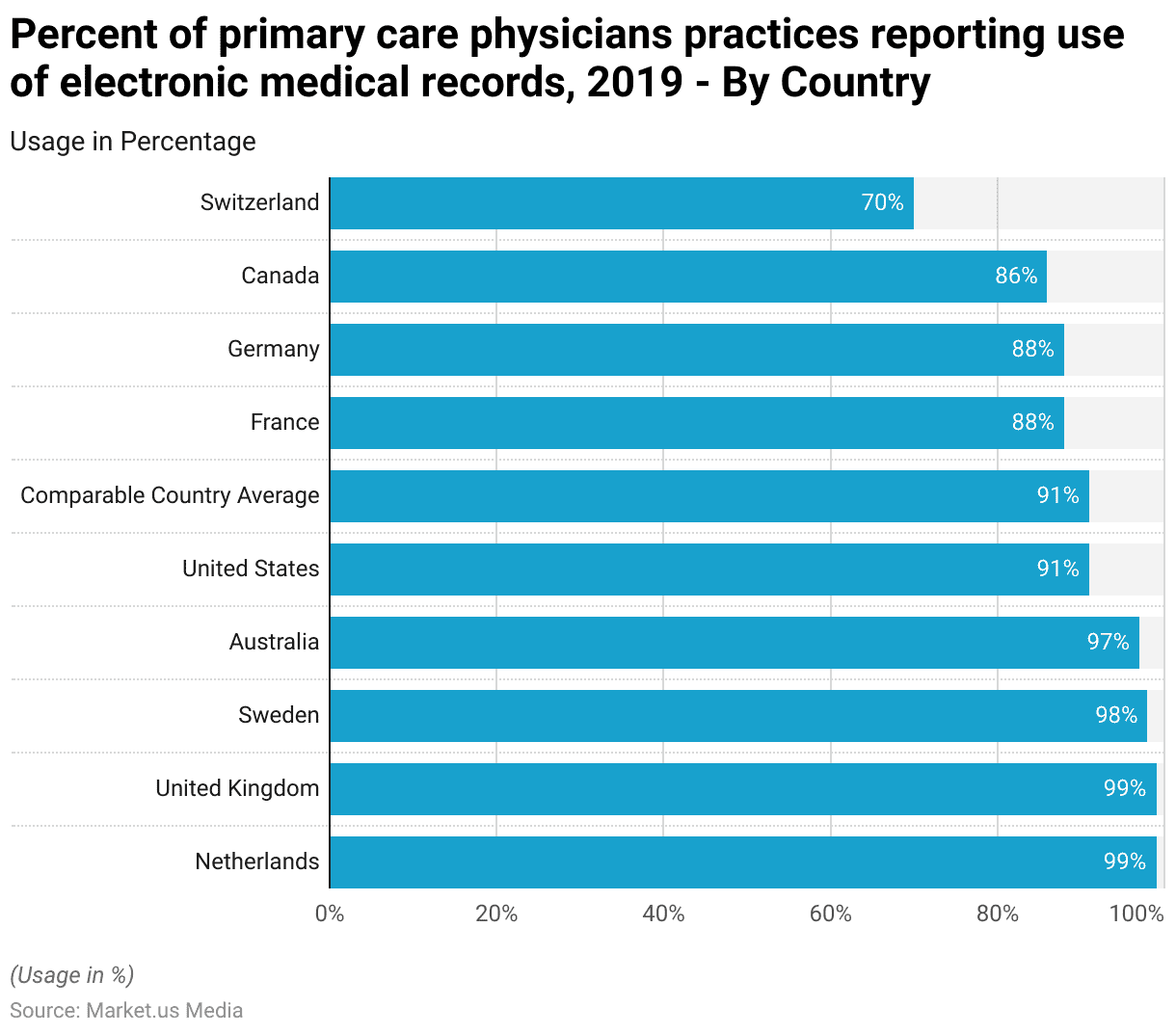
Adoption of Electronic Health Records (EHR) by Office-Based Physicians
- The adoption of Electronic Health Records (EHR) by office-based physicians in the United States has shown a significant upward trend from 2004 to 2021.
- In 2004, only 20.8% of physicians had adopted any form of EHR, with no available data on basic or certified EHR systems.
- Although there was a slight decline in the percentage of physicians using any EHR in 2019 (90%) and 2021 (88%). The adoption of certified EHR systems remained robust at 72% in 2019 and 78% in 2021.

Office-based Physicians with EMR/EHR Systems
- The adoption of Electronic Medical Records (EMR) and Electronic Health Records (EHR) systems among office-based physicians in the United States has seen significant growth from 2004 to 2021.
- In 2004, only 20.8% of physicians had adopted any form of EHR, with no available data on basic or certified systems.
- By 2011, these figures had increased to 57% for any EHR and 33.9% for basic EHRs.
- Significant growth was observed in 2012, with 71.8% of physicians using any EHR and 39.6% using basic systems.
- By 2021, 88.2% of physicians were using any EHR, with 77.8% using certified systems.
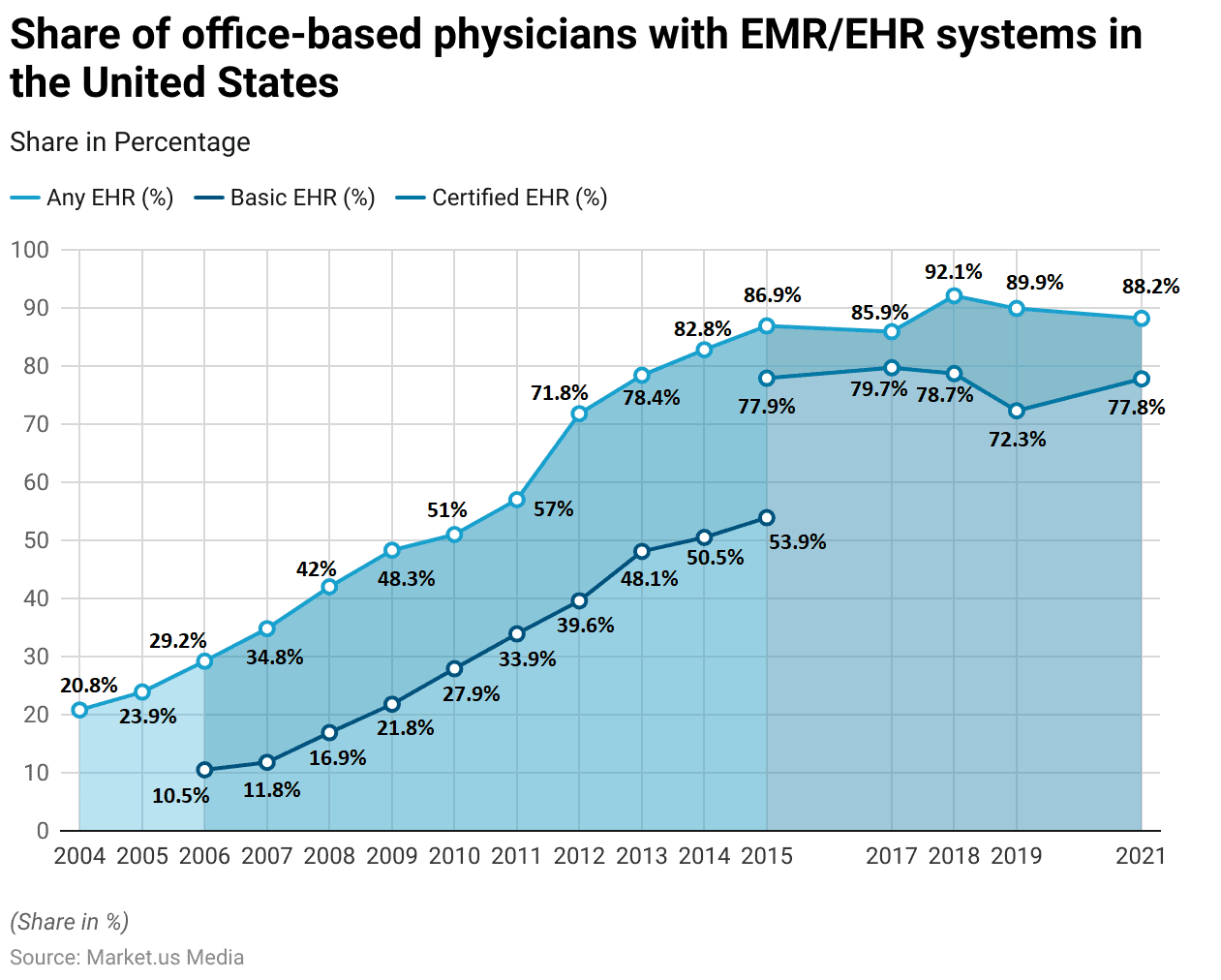
Capability of Physician EHR to Identify Patients for Care
Physician EHR Capability to Identify Patients for Care – By Practice Size
- In 2017, the percentage of office-based U.S. physicians with computerized capability to identify patients due for preventive or follow-up care varied by practice size.
- Solo practices had the lowest adoption rate, with 53.1% of physicians having this capability.
- Practices with two physicians saw a significantly higher rate at 70.2%.
- For practices with three to five physicians, 66.8% of physicians had the necessary computerized capability.
- Larger practices, with six or more physicians, reported a 69.6% adoption rate.
- Overall, 64.7% of office-based physicians across all practice sizes could identify patients due for preventive or follow-up care through computerized systems. Indicating a notable but varied adoption rate depending on the size of the practice.
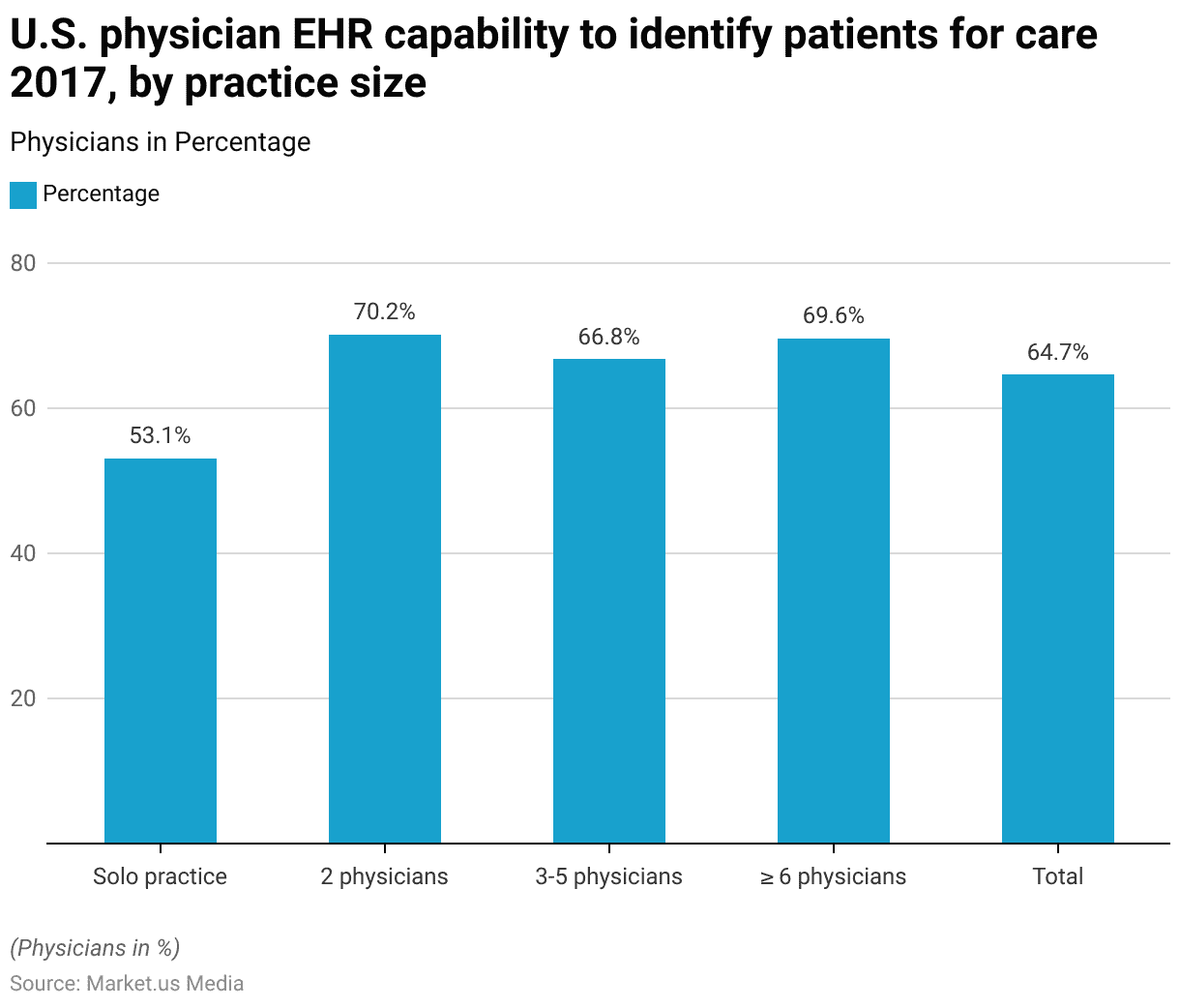
Physician EHR Capability to Identify Patients for Care – By Specialty
- In 2017, the percentage of office-based U.S. physicians with the computerized capability to identify patients due for preventive or follow-up care varied across medical specialties.
- Primary care physicians had the highest adoption rate at 72.9%.
- In contrast, physicians in surgical care specialties reported a lower adoption rate of 54.8%.
- Non-primary care physicians had a computerized capability rate of 58.5%.
- Overall, 64.7% of office-based physicians across all specialties had the necessary computerized systems to identify patients needing preventive or follow-up care.
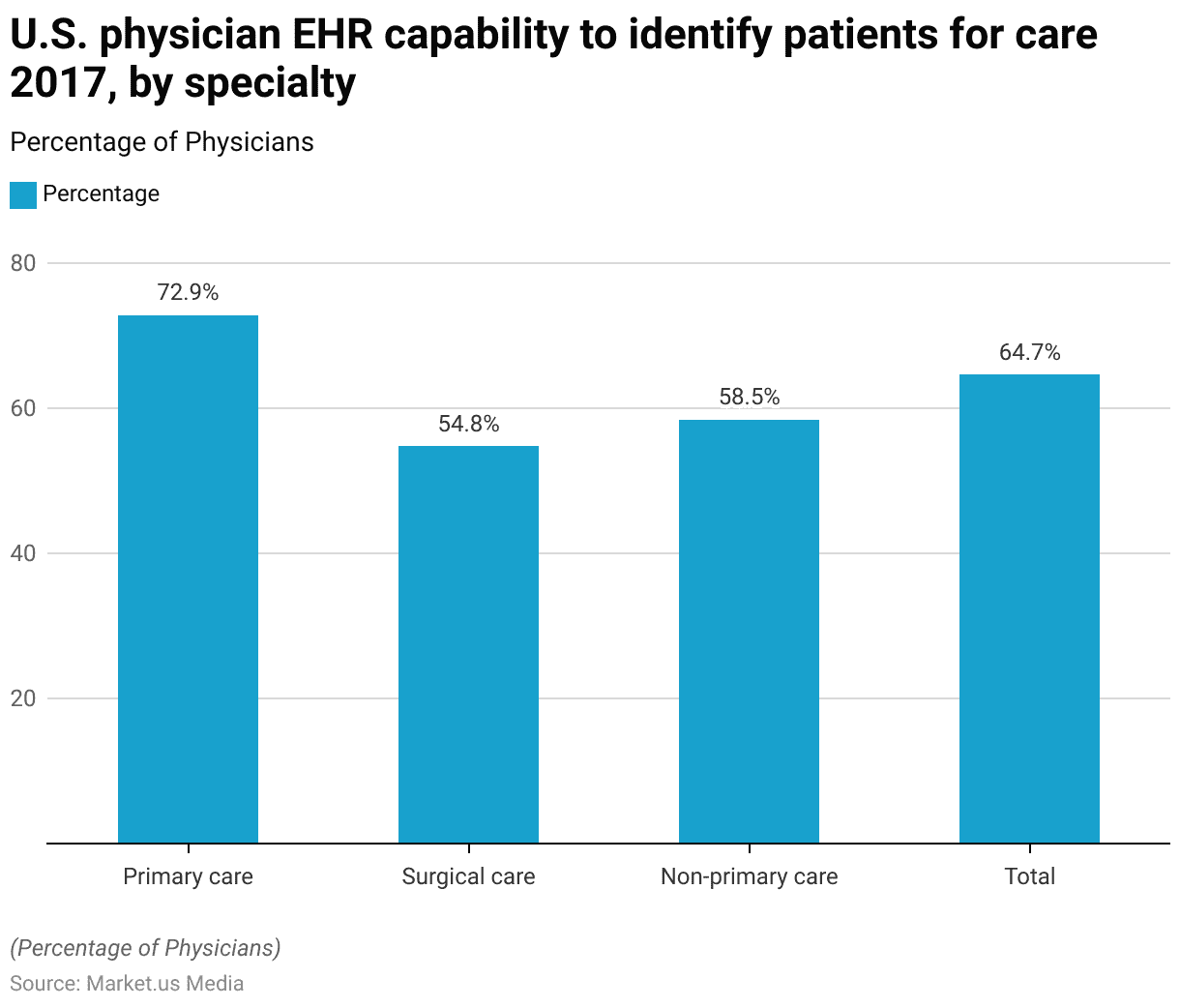
Impact of EHR on Patient Outcomes
- Implementing Electronic Health Records (EHR) has significantly improved various patient outcomes.
- Access to critical information has seen the most substantial enhancement, with an 80% improvement. Facilitating timely and informed decision-making in patient care.
- Preventive care adherence has increased by 30%, underscoring the role of EHR in promoting routine health maintenance and early intervention.
- Hospital readmissions have also decreased by 30%, indicating better patient monitoring and follow-up care.
- Chronic disease management has improved by 25%, reflecting more effective tracking and treatment of long-term conditions.
- Additionally, medication errors have been reduced by 48%, highlighting the EHR’s ability to enhance accuracy in prescribing and administering medications.
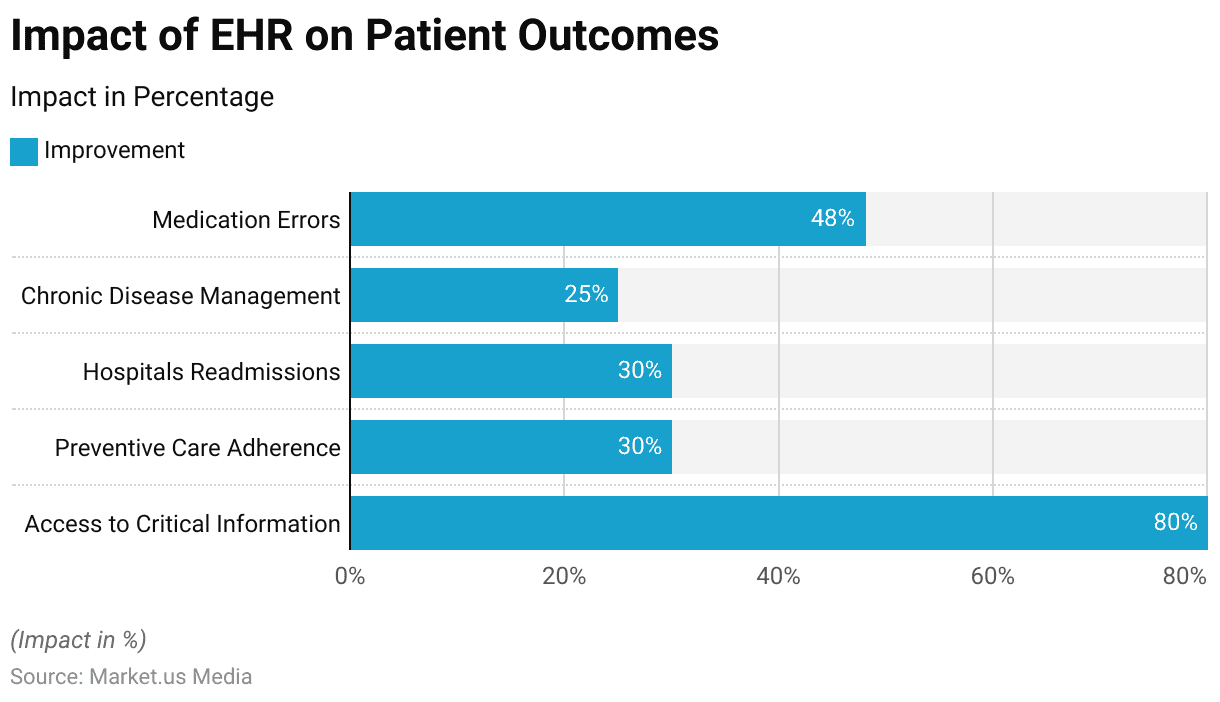
EHR Industry Statistics – By Region
United States
- Certified electronic health record (EHR) systems are implemented in more than 95% of non-federal acute care hospitals across the United States.
- Around 85% of office-based physicians utilize EHR technology in various capacities.
- Approximately 64% of U.S. hospitals exchange patient data electronically with external providers.
- The adoption rate of EHR systems among long-term care facilities stands at approximately 60%.
- Annually, the United States allocates over $3.5 billion towards EHR incentives through the Meaningful Use program.
United Kingdom
- In 2020, the United Kingdom reported the highest technology adoption rate in healthcare, with 87% of clinicians frequently using electronic health records.
- E-prescribing has been adopted by 69% of UK medical professionals. While 52% utilize online booking for appointments, reflecting a notable shift toward digital scheduling methods.
- Approximately 97% of general practitioner offices use EHR systems. EHRs are in place at over 80% of hospitals.
- The UK dedicates over £200 million each year to digital health initiatives, including the implementation of EHRs.
- Shared EHR systems among NHS hospitals have achieved a 60% adoption rate.
Australia
- More than 90% of general practices in Australia now use electronic health record systems, and they are in place at over 85% of public hospitals across the country.
- About three-quarters of specialists also use these systems in their practices.
- Adoption of electronic health records in residential aged care facilities is approximately 45%.
- Australia has committed over AUD 2 billion to digital health initiatives, including investments in the My Health Record program.
EHR Industry Benefits
- The clinical benefits reported by Electronic Health Record (EHR) users indicate significant improvements in patient care and medical practice efficiency.
- Among all physicians using EHRs, 78% reported overall enhanced patient care. This figure rises to 85% for those with Meaningful Use (MU)-certified EHR systems and at least two years of EHR experience.
- Remote access to patient charts was reported by 81% of all EHR users. Increasing to 87% among experienced users with MU-certified systems.
- Alerts for potential medication errors were noted by 65% of all EHR users. Compared to 70% for the more experienced group.
- Similarly, alerts for critical lab values were reported by 62% of all users, with a higher rate of 70% among those with certified systems and extended experience.
- Reminders to provide preventive care were experienced by 47% of all EHR users. Rising to 55% for those with MU-certified systems.
- Lastly, reminders to provide guideline-compliant care for chronically ill patients were reported by 45% of all users, compared to 54% among those with more experience and certified EHR systems.
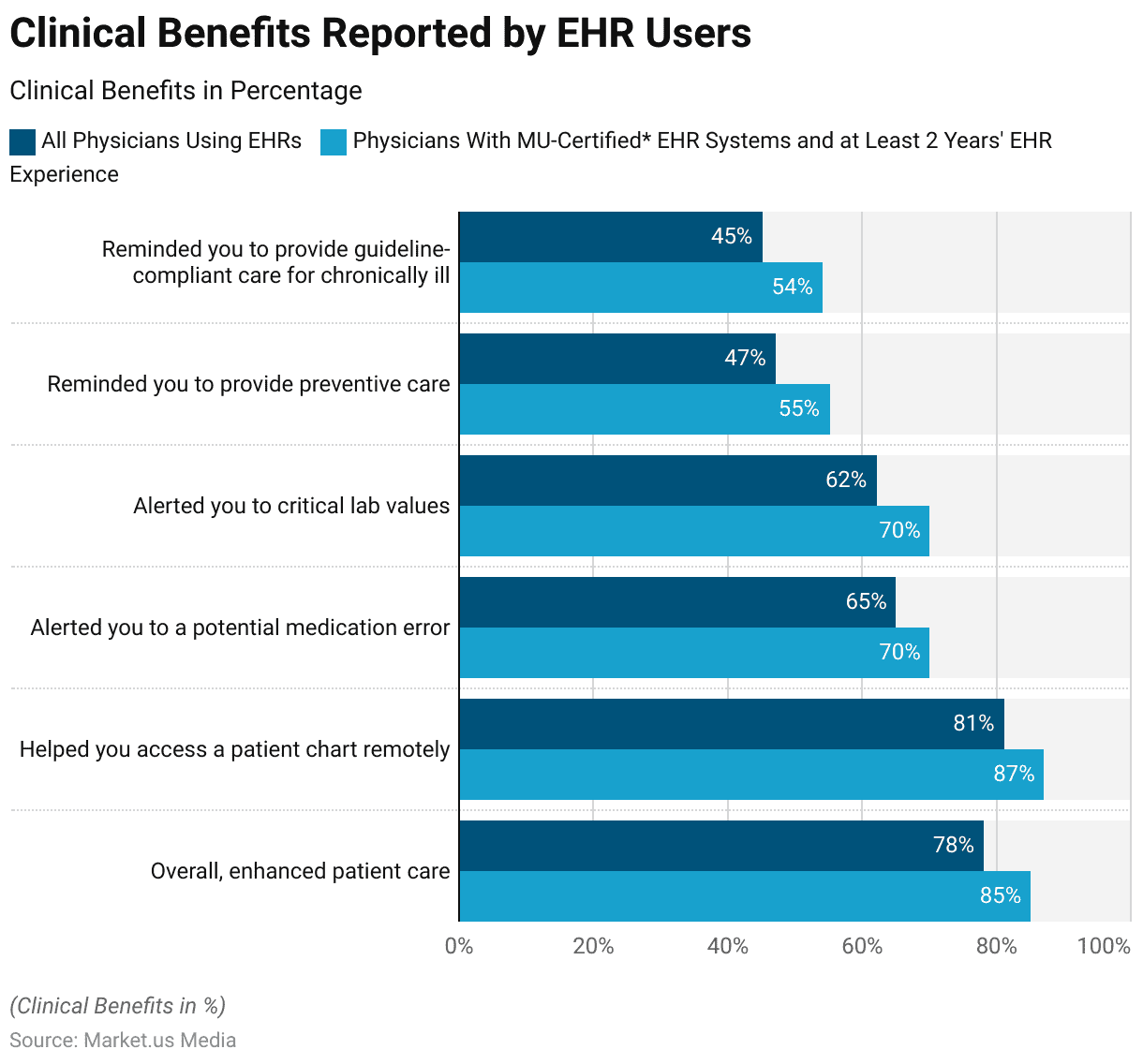
EHR Industry Challenges
- The implementation of Electronic Health Records (EHR) in India faces several significant challenges.
- Security and privacy concerns are paramount, affecting 28% of the implementation efforts, and are closely tied to the issue of lack of interoperability, which also impacts 28% of the initiatives.
- The digital divide, reflecting the disparity in technology access and literacy among different populations, poses a challenge for 19% of the EHR implementation efforts.
- Business continuity concerns, which involve maintaining consistent and reliable operations during and after the transition to EHR, affect 13% of the efforts.
- Additionally, only 3% of the challenges are attributed to the cost efficiency of implementing EHR systems.

Regulations for EHR
- Regulations for Electronic Health Records (EHR) vary significantly by country, reflecting diverse approaches to healthcare data management and patient privacy.
- In the United States, the Health Information Technology for Economic and Clinical Health (HITECH) Act, part of the American Recovery and Reinvestment Act, sets the framework for EHR adoption, emphasizing interoperability and meaningful use of certified EHR technology.
- The 21st Century Cures Act further enhances these regulations by mandating patient access to their health information and prohibiting information blocking, ensuring seamless data sharing across healthcare providers.
- In Europe, the General Data Protection Regulation (GDPR) governs the use of EHRs, focusing on data protection and privacy.
- Countries like the Netherlands and the UK have near-universal EHR adoption among primary care physicians, supported by national health services that standardize EHR implementation.
- Meanwhile, challenges such as security concerns, lack of interoperability, and the digital divide hinder widespread EHR adoptionin India.
Discuss your needs with our analyst
Please share your requirements with more details so our analyst can check if they can solve your problem(s)



